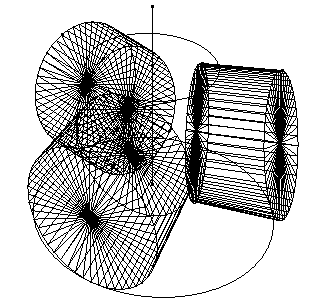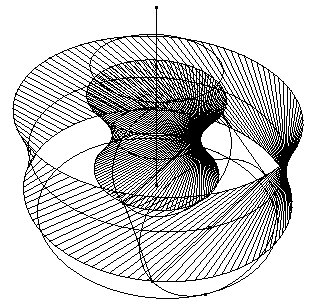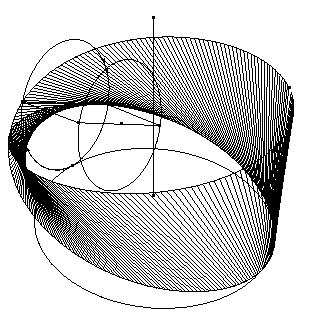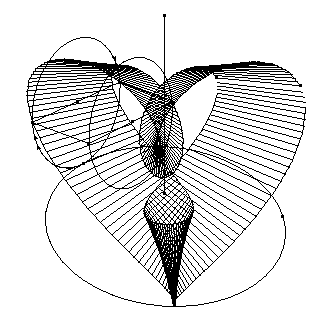"BLEND TOGETHER IN PERSPECTIVE SYMMETRY":
THROUGH THE LARGE GLASS OF DUCHAMP
|
|
Name:
Roberto Giunti, Mathematics teacher, (b. Bagolino, Brescia., Italy, 1956).
Address:
Istituto Leonardo, via Balestrieri 6, 25124 Brescia, Italy
E-mail: roberto.giunti@libero.it
Abstract: The
perspective of the Large Glass was intended to evoke an "emancipated" spatiality,
characterized by higher dimensions and where the metrical traits lose meaning.
This was actually done by combining perspective with transparency and above
all rotatory motion. This article shows by means of examples how this idea
works. A little mention to the problem of verifying the correctness of
perspective is done.
|
1 THE TWO REALMS
OF THE Large Glass
The Bride Stripped
Bare by her Bachelors. Even by Duchamp, commonly known as the Large
Glass, is one of his fundamental works. In four main collections of
written notes, (Sanouillet, Matisse) Duchamp described the project and
his concern with geometry. Two parts constitute the Glass. The higher
part is the Bride realm. It is intended to be a 2D rendering of
a 3D shadow of the 4D Bride (Cabanne, p.40). Duchamp (Sanouillet,
p. 83) points out that in this realm objects lose "all connotation of
men-surated position". The lower part is called Bachelor apparatus
and is located in 3D a environment. It is a complicate machinery drawn
according to a single-point perspective. Its forms are "imperfect"
with respect to those of the Bride, because they are "mensurated".
Thus the note opposes the 3D metric space of the Bachelor utensil and
the emancipated 4D topological space of the Bride. The Bachelor
can
only try to emulate the spatiality of the Bride, also according
to his more general effort of joining with her. Duchampís perspective is
no longer realistic but rather scientific and focused on dimensions (Cabanne,
p.38). Based on the blueprint of the project (containing the exact measures
of each part of the apparatus), I checked the perspective of the
Glass,
showing that it is absolutely canonical and perfectly carried out (Giunti).
2 ROTATING THE LARGE GLASS
Dynamic geometry
software (Cabri Géomètre) allows to move the apparatus,
in order to show that a mix of rotatory motion, transparency and perspective
can emancipate the spatiality of the
Bachelor, by either adding
an imaginary 4th dimension or providing parts of the apparatus
with unexpected topological properties.
Most of Duchampís
notes of the White Box (Sanouillet p.74-101) work by analogy, i.e.
by observing what happens passing from 1D to 2D, from 2D to 3D, and then
extending the outcomes to 4D. An example: to superimpose two chiral 2D
objects a rotation into the third dimension is needed, hence two chiral
3D objects can be superimposed only by rotating into the 4th
dimension. Duchamp put it into practice (Adcock, p.177) in a preparatory
study on glass, entitled Glider Containing a Water Mill (in Neighbouring
Metals) of 1913-15. A semicircular panel of glass can rotate about
its hinge. The panel contains the perspective drawing of a part of the
Bachelor machinery called Glider. Due to its transparency, when
rotated by a half turn, the Glider appears under its chiral version.
Thus we have the suggestion of a turn into the 4th dimension.
The same effect of reversing the whole Bachelor apparatus can be
obtained by walking around the actual Large Glass, swapping the
roles of Glass and Observer in the relative motion.
Duchamp largely
used the analogical reasoning, but he perceived it unsatisfactory and rather
sterile (Sanouillet, p.92). Hence he tried other possible ways, like for
the Sieves. They are seven conic filters disposed in semicircle.
Duchamp left a sketch containing their perspective construction. Once the
ellipse at the base of the first cone was traced, he simply rotated it
using a set of eccentric circles. The Sieves were intended to force
the Spangles (particles of frozen gas) in a circular course, and
the circles used for the perspective construction can be seen as their
trajectories. Now, if we hold the Spangles still rotating the circles
(maintaining the relative motion as done above), we gain an amazing outcome:
due to their eccentricity, the rotating circles give us a very impressive
stereokinetic effect. Thus the plane gives the illusion of a volume. But,
according to the perspective metaphor, we virtually have the illusion of
a hypervolume. Only speculations? Possible, but this is exactly what Duchamp
did a few years later with Anemic Cinema (1925) and the Rotorelief
(1935). Passing through this "labyrinth of the three directions"
the Spangles "imperceptibly lose [Ö] their designation
of left, right, up, down, etc, lose their awareness of position" (Sanouillet,
p. 49); but, for Duchamp, similar swaps left-right, up-down are always
related to the 4th dimension. Related to those swaps there is
another interesting feature. The preparatory sketch of the Sieves
with its semicircles, actually depicts a semi-torus. The loss of distinction
left-right or up-down also means identification. Now, it is well known
that by identifying any pair of its symmetrical points (with respect to
the centre of the torus), one obtains a Kleinian bottle, whose counterintuitive
properties, especially the loss of meaning of inside and outside concepts,
emulate the emancipated properties of the Bride realm space.
Geometrically
speaking, the most interesting device of the Bachelor is the Chocolate
grinder. Three conical frusta (the rollers) rotate (with a sliding
component) on a conical chassis. The roller are carefully ruled with threads,
as the coiling of a dynamo. This connects the Grinder device with
electromagnetism, as definitively documented by Henderson. But Duchamp
also spoke of the threads in terms of "generatrices" (Matisse, entry 36).
Accordingly the Grinder is a very effective generator of ruled surfaces.
This is fully consistent with Duchampís theory of "elemental parallelism"
(Adcock, pp. 137-199) and with his interest in Mareyís chronophotography
(Cabanne, p. 34). Supposing the Grinder at work, we obtain several
ruled surfaces as geometrical loci of the threads. When the rollers slide
without rotating around their own axes, the loci of the diametric threads
are single-sheeted hyperboloids, which are actually mentioned by Duchamp
(Sanouillet p. 83) as examples of geometrical objects which "lose all
connotation of men-surated position" by passing into the Bride
realm. Single-sheeted hyperboloids can be used to create a special type
of gearing, very similar to that one depicted in the Coffee mill
(1911). Even more interesting and complicated bands, belonging to the family
of the Moebius strips, can be obtained as the loci of the threads (of both
the slant heights and top or bottom diameters) under the assumption that
the rollers also rotate around their own axes, while rotating around the
Grinder
axis. Again, rotation allows the
Bachelor to emulate the topological
essence of the Bride space.
   
Finally let us consider the Water
mill wheel contained in the Glider. The rotation of the wheel
was combined with the onanistic left-right sliding of the whole Glider
(Sanouillet, pp. 56-59). While I was working with Cabri to rotate
the perspective drawing of the Water Mill wheel, I serendipitously
discovered a surprising effect. I filled the eight paddles of the wheel
with a grey solid colour, to better appreciate their rotation. But, the
filling order followed by Cabri to repaint the successive frames
of the animation is that followed by the User to create the animated objects,
and not that consistent with the perspective system. Hence, in the animation,
from time to time it happens that the paddles can be painted either according
to the correct foreground/background policy or not. In turn this causes
continuous and unexpected (but stable) swapping in the perception of the
rotation, either clockwise or anticlockwise. In turn, this causes a marked
Necker-cube effect in the overall perception of the Glider, as if
it were seen from either left or right, which finally is fully consistent
with its projected onanistic motion. What is quite amazing now, is that
even if the paddles are drawn transparent, one easily learns to perform
stable mental inversions (clockwise or anticlockwise) if and only if the
device is rotating. Of course similar perceptive swapping into chiral instances
of the same object are connected with rotations into the 4th
dimension. Hence, even if the Bachelor is not as emancipated as
the Bride, at least he is clever enough to find some remedies.
The main objection
one could make against what I presented here, is that the actual Glass
is in fact definitively and dramatically static, which of course is true.
There are no special or magic effects in looking at the Glass. But
what one has to bear in mind is thinking of the Glass, which was
strongly recommended by Duchamp, by stating the primacy of the grey matter
over the retina (Cabanne pp. 38-39). Duchamp said that his notes must be
considered as essential parts of the very Glass (Cabanne, pp. 42-43).
The Glass was conceived in perpetual and ubiquitous motion, with
a particular inclination for circuital courses. Duchamp made clear his
attraction for circular motions (Tomkins p. 125). Furthermore, we have
several notes where Duchamp points out the importance of relative motion
(of subject and object) in the perception of space (Sanouillet, pp. 87-88).
Thus, Duchamp suggests us to move the Glass with our mind. The second point
to make clear is whether or not Duchamp imagined something similar to what
I presented above. The example of the hinged Glider is self-evident.
The stereokinetic effect discussed with the Sieves, will be actually
exploited a few years later (thatís why I consider the perspective study
of the Sieves as the most relevant antecedent of the successive
optical devices). For the rest we have only clues which make us suppose
some possible awareness of Duchamp. He actually cited quadric surfaces,
but not with direct reference to the Grinder. Clair confirmed that
Duchamp knew Kleinian bottle and Moebius band but not referred to the Grinder
or to the Sieves. The strange reversible motion of the Water
Mill is actually consistent with Duchampís notes, but there is no evidence
that Duchamp exactly thought of something similar. Anyway, at least we
can say: Duchamp suggested us a recipe (mix perspective and rotations);
and, when we use it, it works perfectly.
References
Adcock, C.E.
(1983)
Marcel Duchamp's Notes from
the Large Glass: An N-Dimensional Analysis, Ann Arbor: UMI Research
Press.
Cabanne, P.
(1971)
Dialogues with Marcel Duchamp, New York: Viking Press.
Clair, J. (2000)
Marcel
Duchamp et la fin de líart, Paris: Gallimard.
Giunti, R. (2004)
The Bachelor Stripped Bare by Cabri Géomètre, Even, Tout-Fait,
forthcoming.
Henderson, L.D.
(1998) Duchamp in Context: Science and Technology in The Large Glass
and Related Works, Princeton: Princeton University Press.
Matisse, P. (1980)
Notes,
Paris: Centre National díArt et de Culture Georges Pompidou.
Sanouillet, M.,
Peterson, E. (1989) The Writings of Marcel Duchamp, New York: Da
Capo PressTomkins, C. (1996) Duchamp: A Biography, New York: Henry
Holt and Company.

|